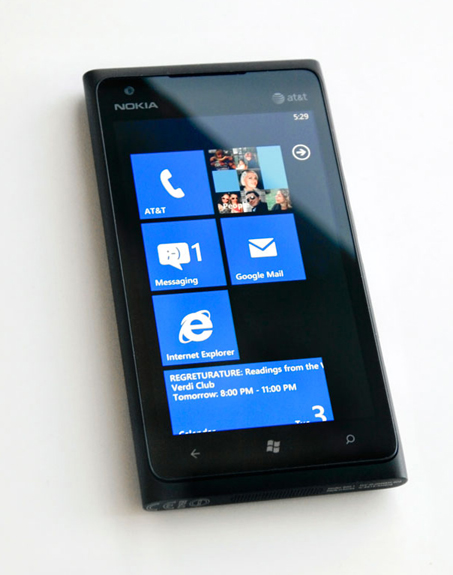A Comeback Phone, Hampered by a Lack of Apps
When the Lumia 900 smart phone made its first public appearance at the Consumer Electronics Show this January, we asked “Can one phone save Nokia and Microsoft?” It’s still too early to say, but after testing the phone, which goes on sale April 8, I can answer a different one: “Is it any good?” The answer is yes, with some caveats.

The Lumia 900 is proof that although Nokia and Microsoft teamed up under duress, as their competitors forged ahead to redefine mobile computing, the partnership makes sense. Nokia has built a high-quality and striking handset, and Microsoft has made a refreshing and likable operating system to run it. Unfortunately, the apps to run on that OS are in short supply.
The handset feels reassuringly robust, underlining Nokia’s reputation as the Volvo of phone manufacturers. All of its components cling to a single piece of a dense, tough plastic known as polycarbonate, with a tactile matte finish. It feels more solid than many Android phones, which are generally made of lighter plastic; compared to the metal and glass iPhone, it feels warmer and less delicate.
The Lumia’s 8 megapixel camera performs well, and a one-megapixel camera on the front gives a good image for video calling.
With a 4.3-inch display, the phone is large, as has become common for the latest Android phones, and as is rumored to be the case for the next iPhone. The Lumia’s display doesn’t have a pixel density to match the latest iPhone–what Apple calls a “retina display”—or recent Android handsets that also boast high pixel counts. Yet Nokia’s phone is powered by an operating system that seems to be better suited to an era of large displays with very densely packed pixels.
Windows Phone does away with the trompe l’oeil buttons, shadows, leather, and canvas that Android and iOS are visually stitched together from. Instead, the Windows Phone interface appears uniformly flat, with typography—in daringly large sizes—to give users the cues they need to easily absorb information from the screen, and understand how they can interact with it.
My experience with the Lumia was that Windows Phone uses text in a way that looks refreshingly different while still being easy to use. The swoops and curves of letters looks great on large, retina-style displays because they have enough pixels to hide the fact that dots on a strict grid are being used to make up those wavy lines.

Windows Phone comes with all the standard features you would expect of a smart phone—such as a reasonably fast browser, a maps application and e-mail client—and adds a few new ideas of its own. On the default screen, “live tiles” act as shortcuts to frequently used apps and also display information such as snippets of calendar events. An impressive “people” app is a contact book that also provides a way to browse data from Facebook, Twitter, and other social sites, and to post new updates to those services.
Throughout Windows Phone, sideways swipes are used to explore further inside an app, an approach that is easily learned. Most people I showed the phone to, or who saw and remarked on it, liked Windows Phone’s design and interface.
Some of Microsoft’s approach is not uniquely its own. The newest version of Google’s Android operating system, Ice Cream Sandwich, features widespread use of sideways swipes and a new, clean-looking font—Roboto—designed with large, high resolution displays in mind. Microsoft has come up with something even more distinctive with Windows Phone, perhaps because it didn’t need to worry about providing continuity to an existing user base. Google reports that more than 200 million Android devices have been activated.
Freedom from user expectations may be the only advantage Microsoft gets from starting so far behind Apple and Google. The most serious disadvantage is the chronic shortage of apps for Windows Phone.
To illustrate, I checked the availability on Windows Phone and Android of apps on two recent “top apps” lists issued by Apple. Of the top 10 on the “Free apps” chart on iTunes today (mostly games), five were available for Android and none for Windows Phone. Of the top 10 “most downloaded” list that Apple released on March 5, all were available on Android and seven for Windows Phone.
Nokia and Windows have between them created an impressive device that’s nice to use. But the lack of apps is a serious enough hindrance that, if asked, I’d advise anyone to wait for the app lag to reduce before buying a Lumia 900, even at the low price of $99. Writing that makes me a contributor to the vicious cycle that is Microsoft’s biggest problem and, by proxy, Nokia’s, too: Until more people own Windows Phone devices, developers will be reluctant to create apps for them. But unless more apps become available, many people won’t want a Windows Phone device.
Even though most apps still debut on iOS first, Google has shown that this cycle can be escaped. If Microsoft and Nokia can keep releasing devices like the Lumia 900, they may manage to earn the respect of both users and app developers. If that happens, the post-iPhone market for phones will be more than just a two-horse race.
Keep Reading
Most Popular
Large language models can do jaw-dropping things. But nobody knows exactly why.
And that's a problem. Figuring it out is one of the biggest scientific puzzles of our time and a crucial step towards controlling more powerful future models.
How scientists traced a mysterious covid case back to six toilets
When wastewater surveillance turns into a hunt for a single infected individual, the ethics get tricky.
The problem with plug-in hybrids? Their drivers.
Plug-in hybrids are often sold as a transition to EVs, but new data from Europe shows we’re still underestimating the emissions they produce.
Stay connected
Get the latest updates from
MIT Technology Review
Discover special offers, top stories, upcoming events, and more.